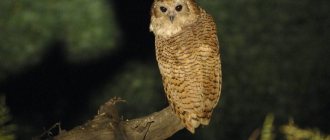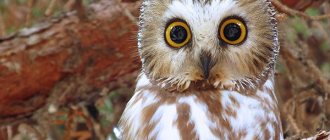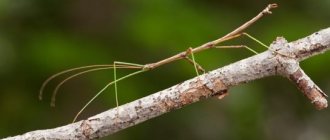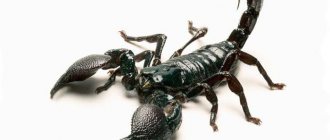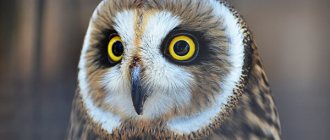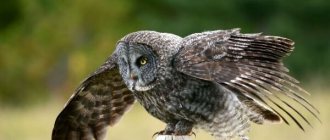The long-eared owl is medium in size, maybe a little larger than a pigeon, representing the owl family. This species is distinguished by the presence of very long feathers located on the sides of the head, in the form of small ears. Long-eared owls are characterized by the same type of plumage color. The main habitats are forests, small areas of green space, and city parks. These are migratory birds that first gather in small groups. It is not so easy to see them, since they prefer to be nocturnal, and during the daytime they hide in secluded places. Their behavior is slightly different compared to other species of owls, and some differences in appearance have also been noticed.
What does an owl with ears look like?
Photos of owls adorn many collections and almanacs on European bird species. The long-eared owl has an expressive appearance, thanks to which it has become so popular. The dense plumage is colored brown and ash-gray. Bright white and yellow inserts create patterns that imitate bark. Thanks to its spotted mosaic coloring, the bird hides well in the crown, grass and branches of bushes.
The head is round, straight set. Large golden or orange eyes are the most expressive part of the bird's appearance. The feather is laid out like a fan around the eyes. This creates the impression of flat space. This is necessary to capture sounds and enhance the bird's hearing. There are strongly protruding tufts of feathers on the head. They create imitation ears. But their purpose is also related to hearing and orientation in flight.
Closer photo
The paws are high and densely feathered. At the ends of the fingers there are strong, dark, sharp claws. The long tail creates balance for the body when walking or flying. During summer, the bird creates a characteristic silhouette - a short oval center and wide, rectangular wings with a slight bend.
The sound of an owl: The sound of an owl can be heard at dusk. The bird emits a deep, booming, abrupt cry. It can be described as: "Ooh-oh." Most of all, it resembles the hum of the wind in a clay vessel. In some subspecies, the cry is similar to “wack-wack-wack”. The fledglings produce a “piiii-piiii” sound.
Owl in a pine tree
Adaptation to a new home
After arriving home, you need to put the box near the place set up for the pet, open it and leave the room. Let the owl fly out of it on its own, calmly look around and get used to the situation. After two hours, you can offer your pet water and food. Little owlets do not yet know how to tear apart mouse carcasses on their own, so it is better to chop them up in advance. At first, it is better not to pick up your pet, not to make loud sounds or make sudden movements. The next day, food can be offered by hand so that the pet gets used to the owner faster. About 10 hours after eating, the owl should regurgitate the undigested skin and bones of its prey. If this does not happen, you should be wary - the bird may have digestive problems. It is also necessary to check whether there is blood in the regurgitated mass or in the stool. In a healthy owl, it is a black solid content surrounded by a white liquid. If the droppings have a foul odor or an unnatural color, it is worth checking with a veterinarian.
Where do owls live
Birds prefer areas that combine forest plantations and open spaces. This is due to its need to search for food and make long flights. Long-eared owls are frequent guests in vacant lots, vegetable gardens, fields and meadows.
Native places of long-eared owls:
- Northern Eurasia;
- North America;
- European part of Russia;
- Western and Central Ukraine;
- Belarus;
- Poland;
- Lithuania, etc.
Owl populations occur in the southern part of the continent from the 63rd to 65th parallel. They choose areas with open spaces interspersed with groves, copses, and gardens. Willingly settles on the outskirts of populated areas, in rural areas. It is not uncommon to find entire families living in summer cottages or in abandoned buildings. Long-eared birds choose places where the terrain is rich in ponds and ditches. Habitats are tied to the food supply.
Photo of a long-eared owl
Representatives of small breeds
Having talked about the largest representatives of the family, it is worth mentioning separately about the small owls. Indeed, despite their modest size, many are very interesting birds.
Of course, the smallest owl is the Scops Owl. It weighs no more than 100 grams.
The only slightly larger variety of owls is the Ussuri owl.
The bobwhite owl has approximately the same size.
What’s interesting is that all three birds are migratory, preferring to spend the winter in Africa or South Asia.
Types of long-eared owls and their appearance
The classic long-eared owl (Asio otus) is considered the standard by which the appearance of other feathered relatives is described. Short-eared owl (Asio flammeus) - has a pronounced “mask” framed by a white edging. There are practically no ears, the plumage is gray-brown. The body height of the bird is up to 25 cm, less often 30 cm. It has a slender, elongated body. The eyes are golden in color with a dark frame of feathers. The key is narrow, flattened on the sides. The low body position practically hides the paws; they can only be seen if you look at the bird from the front.
Asio otus
The Central American long-eared owl (Asio stygius) has 3 types of classic colors: dark gray, brown closer to ocher and dark brown. Like its European relative, it has ears on its head. They are fluffier and shorter. There are two feather ridges around the eyes, which resemble the shape of eyebrows. The owl is large, body size is more than 35-40 cm.
Asio stygius
The Abyssinian long-eared owl (Asio abyssinicus) has two types of appearance with and without ears. The first type is lightly colored, the plumage has dull soft shades of gray, brown and yellow. The length of the plumes of the “ears” is up to 3-4 cm, protruding above the head. The second type has dark brown plumage with black inserts, a round head without ears. The mask is outlined with white and brown plumage. They settle in pine thickets and light groves.
Asio abyssinicus
The African long-eared owl (Asio capensis) is the smallest member of the genus. The bird's body is up to 30-37 cm and weighs up to 224 g. There are no ears, the head is round with a pronounced mask. The eyes are red or dark amber, surrounded by a black halo. The beak is flattened, black. The plumage is practically spotless and dark brown in color. Females are heavier and larger than males.
Asio capensis
The Madagascar long-eared owl (Asio madagascariensis) has a distinctive appearance. The body size is 40-52 cm, thanks to which it is recognized as the largest of its kind. The upper part of the plumage is dark brown. The chest and underbelly are painted in orange and golden tones, with dark accents. On the wing and tail there are streaks forming a striped pattern. On the mask there is a gray plume of feathers around the key. The head is visually smaller than the rest of the body, the eyes are large and dark without a bright iris.
Asio madagascariensis
Natural enemies
The golden eagle is a predator capable of attacking owls.
Natural enemies of owls include larger birds that lead a predatory lifestyle. Among them are golden eagles, hawks and eagles. Thanks to their massive body and sharp beak, they easily win the fight and eat their prey.
Interesting fact : the main problem for a predator is not enemies, but the lack of food. In many areas, there are not enough animals and birds that are part of the owls’ diet, so approximately 25% of them go to the next world due to hunger.
Chicks have their own natural enemies. If an owlet falls out of its nest, it is likely to be eaten by a carnivore living in these areas. These include fox, raccoon and ferret.
Humans have a detrimental effect on owls. Every year large volumes of forests are cut down, which is why different species are forced to leave their usual territories and go in search of new ones. The gradual deterioration of the environmental situation also has a detrimental effect on the bird population. And in some regions, different types of owls are even hunted.
What does a long-eared owl eat?
The long-eared owl's diet includes animal and plant foods. The basis is made up of small and medium-sized rodents. The owl hunts mice, voles, rats, hamsters, and pikas. She can catch lizards. Small birds are not uncommon in the diet. It can attack young poultry if it settles near a human dwelling. Among plant foods, it consumes only berries from bushes and trees.
Long-eared owl diet formula:
80:15:5
- Where 80% are rodents and mice;
- 15% small birds and lizards;
- 5% berries.
Hunting takes place at night and begins at dusk. It attacks silently and navigates by hearing. Selects a victim and dives at it smoothly from the summer. The bird has a specific digestion; it swallows its prey whole. But unlike other birds, it does not swallow pebbles to grind the contents. She regurgitates undigested remains, bones, fur and teeth. This lump is called "nasty". Using them, ornithologists determine the owl’s diet and preferences.
She feeds her babies with burps. This is a broth made from digested meat and milk secretions that provide immunity to the chicks.
Long-eared owl in flight
Long-eared owls do not build nests. To suit their needs, they choose rocky depressions, hollows, and attic spaces with rubbish. The nest itself may consist of tufts of grass and small branches randomly scattered around an impromptu incubation site. The inside of the nest is not lined with feathers.
There are 3-5 eggs in a clutch. The long-eared owl does not lay eggs immediately, but hatches from 1 egg. As a result, the nest may contain chicks of very different sizes. The plumage of young owls is light, fluffy with gray streaks.
The offspring are raised in pairs. Owl families are created during the period of laying and raising chicks. They raise their children until adolescence. At 3 months of age, the young look like an adult bird.
Eared in a hollow
How it gurgles and what sounds it makes
They say about the long-eared eagle owl that it hoots. The hoot or spring love song is the name given to the sounds made by males during the mating season. The pause between sounds: “Guu, guuu, guuu” lasts no more than 3 seconds. The male's voice is dull.
The female sings rarely: “Heev, heev, hevv” in a high, hoarse voice. True nature lovers had the opportunity to hear the rare singing of an owl duet. When an owl is fussing or restless in the nest, its sounds of “Quack, quack” or “Quick, quack” are heard in response to the dull hooting of the male. The fledglings whistle hoarsely at night.
Conditions of the long-eared owl at home
The long-eared owl has a stable psyche. Therefore, of all wild birds of prey, it is one of the few that can be kept in captivity.
Aviary. Must be large and spacious. It is not recommended to keep birds in barns or at home. For harmonious development, she must move and fly a lot. Therefore, the size of the pavilion can be up to 10 sq.m. Branches and imitation bushes should be installed in the room. The bird loves to rest on branches; perches can be placed around the pavilion.
Feeding. Long-eared owls are fed live food and purchased rodents are used. The bird must hunt freely so as not to feel discomfort. The room must be well insulated so that live food does not scatter. It feeds at night and rests during the day.
Reproduction. If a couple is going to start a family, they can be placed in a separate enclosure. It is necessary to provide the bird with secluded places to hatch chicks.
Owl on a branch
Origin
It is believed that the first owls appeared approximately 65 million years ago, during the Eocene period. However, the remains found indicate that their appearance was far from modern. The species of this bird that lived during that period of time are classified into separate genera: Eostrix, Strigogyps and others. They are now considered extinct. Modern owls evolved about a million years ago.
Their hunting method significantly influenced their evolution.
Owls stand motionless, listening to the slightest rustles. They are able to accurately determine the position of the target and the distance to it. Having prepared itself, the predator takes off and grabs the prey with its claws. This is why owls switched to a nocturnal lifestyle, since it is easier to maintain the element of surprise. In the future, this was reflected in the appearance and characteristics of the body. Interesting fact : some species of owls can hunt during daylight hours. For example, these include individuals living in the Arctic, where the polar day can last more than 24 hours.
Interesting facts about the bird
- The bird's wing provides ideal aerodynamics in flight. The muscular system allows the wing to be moved to a semi-vertical position to change low-level flight into a dive.
- The bird hears the rodent from a distance of 5-9 m.
- A bird's vision allows it to navigate well in a forest or field. Additional means of orientation are feathers of “ears” and masks. They pick up air vibrations and sounds, sending signals to the owl.
- The long-eared owl has the most versatile information processing apparatus. The lobes of the brain responsible for this are clearly expressed. It can distinguish and analyze 1000 signals.
- Until the 17th century, the symbol of the owl in Christianity was associated with dark magic. And only later, thanks to the Age of Enlightenment, it began to mean science, wisdom and knowledge.
- In Ancient Egypt, the owl was considered a messenger of the gods. She was revered and even mummified. The owl symbol entered the Egyptian alphabet.
- The owl uses its call to communicate or call a partner. The rest of the time she is silent.
- The owl does not build its own nest, so it willingly takes away the homes of crows and magpies.
- The chicks do not leave the nest immediately. They gradually move to neighboring branches. Up to 3 months of age, adult birds feed their offspring, preparing them for adulthood.
Long-eared owl in a pellet
Listen to the voice of the long-eared owl
The audio tag is not supported by your browser. Close
What does it eat?
Since owls live in many territories, their diet is extensive. Large predators hunt small birds, rodents, lizards and fish. Individuals with small dimensions can get by only on insects. Owls drink little water, since the supply of fluid in the body is replenished when eating food. If necessary, birds are able to fly to ponds and puddles.
Owl preparing to grab prey
Snowy owls can even attack young foxes. And species living in polar regions mainly prefer voles and hares. Little owls hunt rodents in agricultural areas, which greatly helps humans.
Interesting fact : owls do not eat carrion. They are always on the lookout for live prey, and store food in their nests for the winter.

